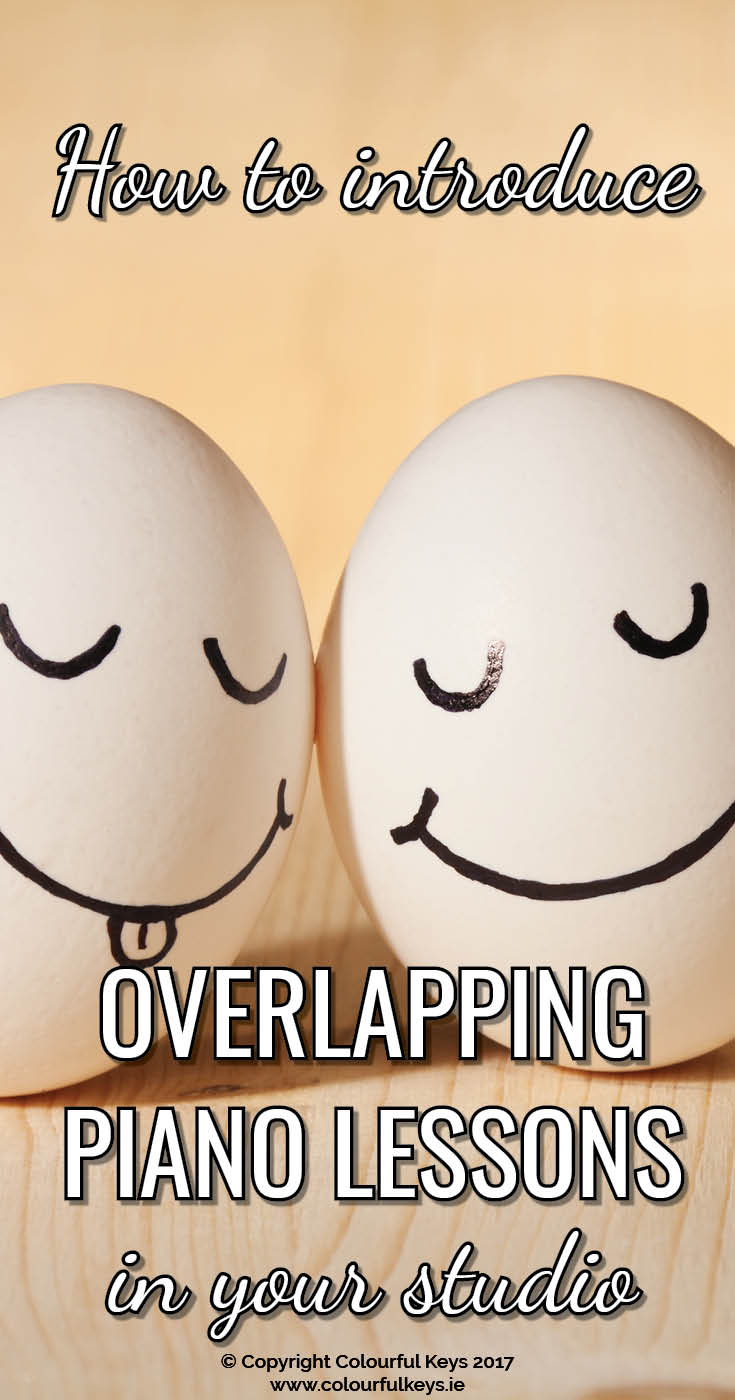Have you heard the buzz around what I call “buddy lessons”?
This is what I call lessons where a student has some time one-on-one with the teacher, and then overlapping time with the next student. Some teachers also call this semi-private lessons.

A few weeks ago I shared a mega-post with all the activities we get up to in my buddy lessons. I’m back on the topic today to talk about the logistics and how to introduce buddy lessons.
If you’re considering bringing in buddy lessons in your studio, this article will take you through all the practicalities you need to consider.
- How long will the buddy lessons be?
- How much should they cost?
- How can I work the schedule?
I’ll answer all these questions for you today. Let’s get started.

Subscribe to updates and get the Buddy Lesson Logisitics Cheatsheet
Enter your details to subscribe to the newsletter for piano teachers with information, tips and offers.
I hate spam as much as you do! I'll only send you information that's directly relevant to music teachers and you can unsubscribe at any time.
Vibrant Music Teaching members, you can access this resource inside the VMT library.Not a member yet? Find out more about becoming a member here.
Format Options
Before you introduce buddy lessons you need to know exactly what you’re introducing.
There are no rules here. The solo time and overlapping time can be any length you decide…which is what can make this confusing.
Let me start by explaining the choice I made for my studio, and why.
There are two options for buddy lessons at my studio:
- 40 minute buddy lessons: 20 minutes solo + 20 overlapping time
- 60 minute buddy lessons: 40 minutes solo + 20 overlapping time
There are several factors that went into my decision, and that could help make your choice clearer.
Two Options
I knew I wanted to have two lesson length options because I teach so many preschoolers. If you only teach students over age 7, I don’t think you need the shorter option.
Overlap Duration
My first priority was to keep the overlapping time consistent. This means that I can match students who are taking different types of buddy lessons together or increase one when necessary – without needing to change their buddy.

So why did I choose 20 minutes? Why not 15 or 30?
I didn’t choose 30 minutes because I knew that would only make sense if I also did 30 minutes solo time. And I know from experience (even with the buddy time) that 30 minutes feels rushed for almost all students.
I’m not a fan of half hour lessons. This would’ve been a step backwards for me.
15 minutes on the other hand, just felt too short for overlapping activities. Setting the scene for a concept and then two reinforcing activities fits much more nicely into 20 minutes.
Finding Your Perfect Format
Think through each of these 60 minute buddy lesson possibilities and imagine yourself teaching these lessons:
- 20 minute overlap + 40 minute solo
- 15 minute overlap + 45 minute solo
- 30 minute overlap + 30 minute solo
Does one jump out at you? Choose that one.
If they all feel the same to you, go with 30 + 30. It’s the most time efficient, and therefore the most profitable.

Subscribe to updates and get the Buddy Lesson Logisitics Cheatsheet
Enter your details to subscribe to the newsletter for piano teachers with information, tips and offers.
I hate spam as much as you do! I'll only send you information that's directly relevant to music teachers and you can unsubscribe at any time.
Vibrant Music Teaching members, you can access this resource inside the VMT library.Not a member yet? Find out more about becoming a member here.
Payment Structures
I think the best approach to come up with a fee for buddy lessons if you’re coming from a one on one format is to:
- Take the rate for the actual time this will take up in your schedule.
- Take the rate for the time the student is receiving.
- Split the difference.
Let me give you an example.
If you’re going to do 30 minute solo + 30 minute overlapping time your student will receive 60 minutes of tuition. But they will take up 45 minutes in your schedule (since you’ll schedule two students for a total of 90 minutes).
So make your buddy lesson rate the equivalent of 52.5 minutes of your regular lesson rate. If you charge $100 per hour that would be $87.5 per 60 minute buddy lesson.

Of course, you can round up or down from there. But it will give you a ballpark figure to work from.
You can then create your monthly, semester or term tuition rate from there.
Still confused about calculating the fees?
I’ve included a handy formula in this cheatsheet so you can just plug in your numbers and be good to go.

Subscribe to updates and get the Buddy Lesson Logisitics Cheatsheet
Enter your details to subscribe to the newsletter for piano teachers with information, tips and offers.
I hate spam as much as you do! I'll only send you information that's directly relevant to music teachers and you can unsubscribe at any time.
Vibrant Music Teaching members, you can access this resource inside the VMT library.Not a member yet? Find out more about becoming a member here.
Making the Change
Once you have the format and fees figured out, you’re ready to start the process of switching students over.
But how exactly can you go about that?
Choose a Strategic Starting Point
Don’t pull the rug out mid-year. Be patient and introduce buddy lessons at the start of a new year, or at least the start of a new semester.
Once you’ve decided when the buddy lesson format will be brought in, you can plan when to inform parents about the exciting new option. I recommend about a two month lead time.
Introducing to Parents
The first thing you need to do is get your piano parents acquainted with this new format and its benefits. If you need a starting point for citing benefits, many of the benefits of partner lessons will apply here too.
Make sure you’re clear but concise when you tell parents about your new buddy lesson option. Read your words back from a non-musician’s perspective. Does it make sense?

Better yet. Read it back with the radio or TV on from a non-musician’s perspective. Does it still make sense?
People are busy. If something seems confusing they will tune out, and they’ll stick with the status quo.
Recommend, Don’t Just Inform
Whenever you make a change like this, it’s best to recommend the new option to your piano parents.
Don’t force it on them, but don’t just display the option either. Let them know which choice you think is best for their child – then let them make the final call.
Most parents will defer to your expertise when the information is given in this way. Some won’t, and that’s fine too.
Be open to some opting out of buddy lessons in the beginning. You can always make the recommendation again down the track when you have more fantastic success stories to share.
Scheduling and Matching
Now you know which students need buddies, it’s time to match them up!
There are three factors when deciding on how to schedule your buddy lessons.
- Student age
- Student level
- Scheduling availability
Phew. That looks insurmountable, eh?
The key to my success with this scheduling puzzle is two-fold:
- I don’t mind mismatched piano buddies.
- My scheduling preferences form is opt-out, not opt-in.
Mismatched Piano Buddies
I decided early on when I was deciding to introduce buddy lessons that I didn’t mind if my piano buddies weren’t perfectly aligned in age or level.
I insist on good matches for partner lessons (students are together for the full duration) but I can do buddy lessons without that perfect fit because we still have solo time too.
Even if I have an advanced 11 year old with a beginner 6 year old, I can still arrange duets, improvisations and games with that pair. It’s more challenging for my lesson planning – but still just as beneficial for them.
Therefore I do my best to match closely on age as a first preference, then on level. But I don’t fret if there’s a discrepancy.
Opt-Out Scheduling
On my enrolment form families have to cross off all the times that won’t work for them. This simple trick makes it much more likely that they’ll leave multiple options than if you just ask what times will work.

Armed with all that information I get to staring at the excel spreadsheet until solutions magically appear.
Yes, that’s as magic as it gets I’m afraid. No pixie dust here, but I do manage to find solutions that work for everyone and fit them all into my schedule.

Subscribe to updates and get the Buddy Lesson Logisitics Cheatsheet
Enter your details to subscribe to the newsletter for piano teachers with information, tips and offers.
I hate spam as much as you do! I'll only send you information that's directly relevant to music teachers and you can unsubscribe at any time.
Vibrant Music Teaching members, you can access this resource inside the VMT library.Not a member yet? Find out more about becoming a member here.
More on Buddy Lessons
If you want to know what to do in your buddy lessons, read this post and get the freebie: The Ultimate Compendium of Buddy Lesson Activities
Do you have more questions about buddy lessons that I haven’t answered yet? Ask them in the comments below or hit me up in the Vibrant Music Studio Teachers community on Facebook.

Fantastic article, Nicola. I tested buddy lessons this past fall with one pair and the kids really like it. Love the 40/20 option; for some reason I never thought of that. Thank you!
Great to hear that you’re having success with it too Helen! I love my 40-20 lessons. Those are my favourites. 🙂
Hi Nicola – thank you so much for this series about buddy lessons. This is so brilliant!
One question: How do you handle sibblings. Normally I teach them back to back – how do you plan your schedule with them? Do you match them or do you try to match them with the students before and after?
Siblings become piano buddies. As I said, I’m ok with buddies who aren’t evenly levelled, and I know how much better it is for parents to leave siblings here for an hour or more, than to sit and wait with one in the car and yoyo back and forth.
Okay, I guess today I am just mathematically challenged. But when I take the example you have given on this page and plug in to the cheatsheet I’m not coming up with the correct fee. Could you please take your example and plug in to the cheat sheet. Normally, I can figure this out..
Well, if you don’t get my formula maybe work it out in your own way? Sorry I can’t be more help but it’s very hard to explain better than that without actually speaking with you Karen. If you’re a VMT member be sure to join me on the next office hour and we can chat about it.
Hi Nicola
Thank you so much for all the detailed information. SO very helpful!
I wanted to ask if you would charge a student the price for their actual time in the class. For example, if the buddy lesson is 60 min total (20-20 division per buddy), would you charge each student for 40 minutes of instruction? If not, why?
Thank you
Hi Nora,
As I explained in the post, I split the difference between the time they will receive and the time they take in my schedule. This is so that I make extra for this time as it does take more planning, but parents still feel like they’re getting a good deal and not paying for one-on-one time that they’re not receiving.
Hi Nicola, I had a question too! I used your cheatsheet, and thought I had it all figure out. But then I realized that my piano buddies have been paying the same fee as solo students. In your reply to Nora, you said that you are actually getting paid more for buddy lessons than solo lessons. So, piano buddies don’t get a discount?
No they don’t. They pay for about 52 minutes for a 60 minute buddy lesson, but this only takes 45 minutes of my schedule. It helps to think about it in terms of pairs of buddies rather than 1 at a time.
Hi Ma’am,
I’m finding it so hard to make the calculation.. it’s just not clicking me. I mean maybe I’m not able to get it the way you wanting to explain here. Wud appreciate your help and guidance. Thank you.
Hi Nitin! You might find these calculators useful: https://colourfulkeys.ie/music-lesson-rates/